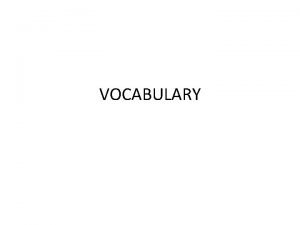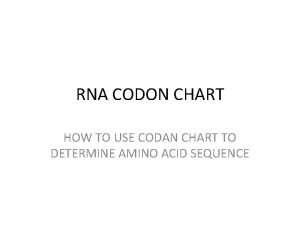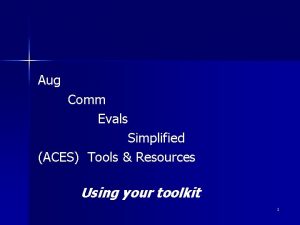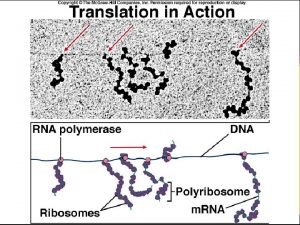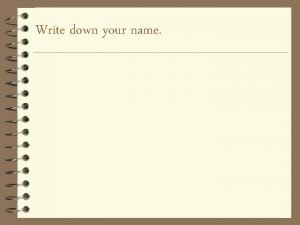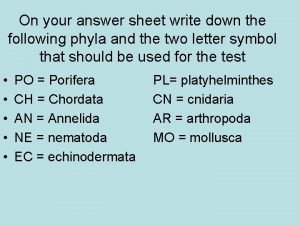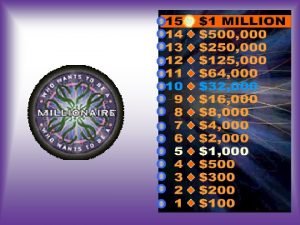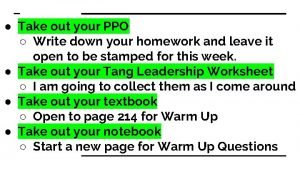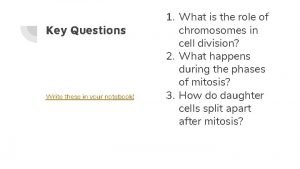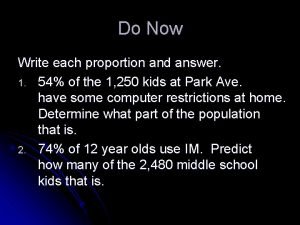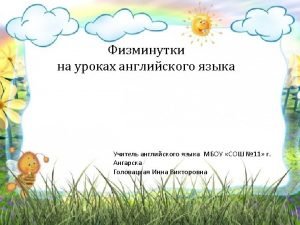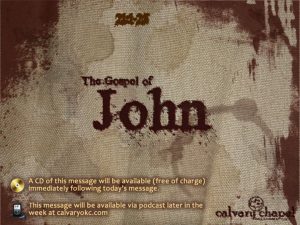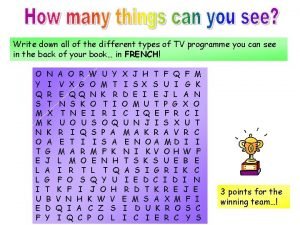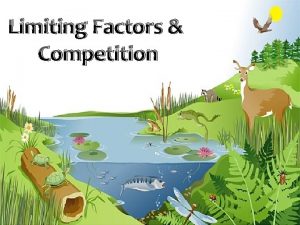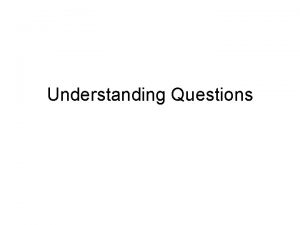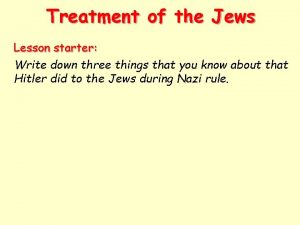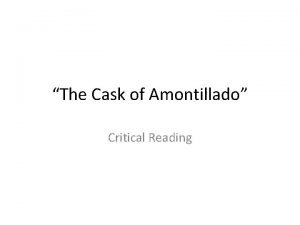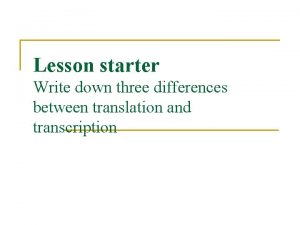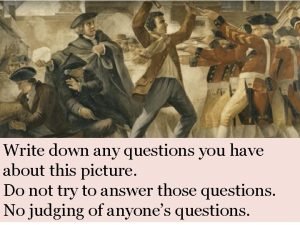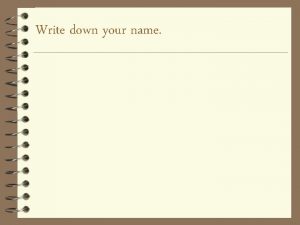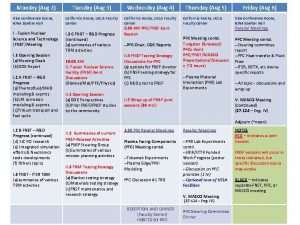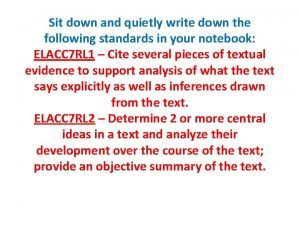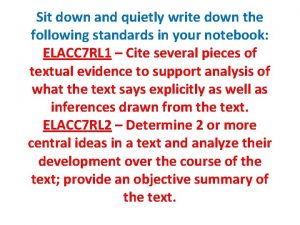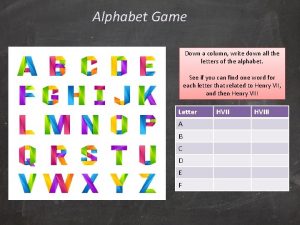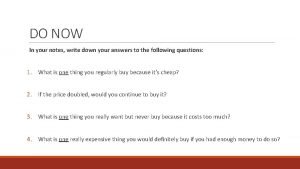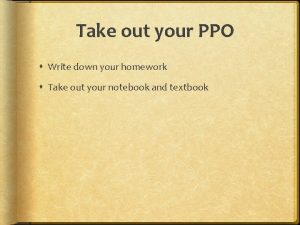Friday AUG q th 19 Write down your








































- Slides: 40

Friday - AUG. q th 19 Write down your Homework in your agenda. q Cell Project – DUE September 7 th q Opening: q How would you define Living Things q Mini-Lesson: q q q The Basic Cell Analogies – The Hunger Games https: //www. youtube. com/watch? v=Xo 9 L 2 FB 7 a. Do Note-Taking The Microscope q Reading/Writing q Cell Workshop City Analogy q Closing/Summarizer: q REVIEW


Standard S 7 L 2. Students will describe the structure and function of cells, tissues, organs, and organ systems. a. Explain that cells take in nutrients in order to grow and divide and to make needed materials. b. Relate cell structures (cell membrane, nucleus, cytoplasm, chloroplast, and mitochondrion) to basic cell functions. Related Elements: b. Compare and contrast that organisms reproduce asexually and sexually (bacteria, protists, fungi, plants and animals). c. Recognize that selective breeding can produce plants or animals with desired traits.

Essential Questions 1. How do you explain the relationship between the structure and function of cell organelles? 2. How do the structures in a cell affect the cell’s function?

All Living Things are Made of Cells http: //youtu. be/g. Fu. Eo 2 cc. TPA Introduction to Cells

All Living Things are Made of Cells Cell – the smallest unit that can perform all the processes necessary for life. Not discovered until the invention of the microscope in the mid-1600 s.

Cell Size Most cells are too small to be seen without a microscope. Few large cells ◦ The yolk of a chicken egg Many small cells ◦ Larger cells need more food & produce more waste. ◦ So, more materials must pass through its outer surface.

What differences do you notice between these two cells?

Prokaryotes Single-celled organisms that do NOT have a nucleus ◦ DNA (genetic material) is found floating in the cytoplasm ◦ Lack many cell structures, but do have ribosomes (structures that make proteins) ◦ Covered by a cell wall and cell membrane ◦ Includes: Bacteria (Archaebacteria & Eubacteria)

Eukaryotes An organism made up of cells that have a nucleus enclosed by a membrane Largest cells ◦ 10 x larger than most bacterial cells Many different organelles ◦ Structures that perform specific functions within the cell Includes: animals, plants, fungi & protists

Two Kinds of Cells (TOC #28) Prokaryotes Eukaryotes Cells that do NOT have a nucleus Cells that have a nucleus Pro = No Eu (“you”) = Yes Smaller cell; lacks Larger cell with many cell structures Bacteria Every living thing EXCEPT bacteria (Protists, Fungi, Plants & Animals)

Warm Up Is this cell a prokaryote or eukaryote? How do you know? Brain Pop Video: Cells

Cell Structures

Eukaryotic Cell Organelles and Function 1. ◦ ◦ Nucleus Nickname: “The Control Center” Function: holds the DNA Parts: Chromatin: strands that contain genetic material Nucleolus: dark spot in the middle of the nucleus that helps make ribosomes Plant and animal cells

Eukaryotic Cell Organelles and Function 3. ◦ ◦ Endoplasmic Reticulum (ER) Nickname: “Roads” Function: The internal delivery system of the cell Located: Cytoplasm Plant and animal cells

Eukaryotic Cell Organelles and Function 2. ◦ ◦ ◦ Ribosomes Function: makes proteins Found in all cells, prokaryotic and eukaryotic Located: Cytoplasm

Eukaryotic Cell Organelles and Function 4. ◦ ◦ ◦ Golgi Complex Nickname: The shippers Function: packages, modifies, and transports materials to different location inside/outside of the cell Appearance: stack of pancakes Located: Cytoplasm Plant and animal cells

Eukaryotic Cell Organelles and Function 10. ◦ Cell Membrane Functions: separates the inside of the cell from its environment Controls what substances enter and leave the cell ◦ Oxygen, carbon dioxide, wastes, food, etc… Located: In plant cells, it is to the inside of the cell wall In animal cells, it is the outermost part of the cell

Eukaryotic Cell Organelles and Function 6. ◦ ◦ Mitochondria Nickname: “The Powerhouse” Function: Energy formation Breaks down food to make ATP: is the major fuel for all cell activities that require energy ◦ Located: Cytoplasm ◦ Plant and animal cells

Eukaryotic Cell Organelles and Function 7. ◦ Vacuoles Function: Plant Cells Very large stores water This is what makes lettuce crisp When there is no water, the plant wilts Animal Cells ◦ Smaller than in plant cells Stores/releases waste products used in cellular digestion Located: Cytoplasm

Eukaryotic Cell Organelles and Function 5. ◦ ◦ Lysosomes: circular, but bigger than ribosomes) Nickname: “Clean-up Crews” Function: to break down food into particles the rest of the cell can use and to destroy old cells Located: Cytoplasm Plant and animal cells

Cytoplasm • Gel-like material inside the cell in which the cells organelles “float” • Found in ALL cells

Eukaryotic Cell Organelles and Function 8. ◦ ◦ Chloroplasts Function: traps energy from the sun to produce food for the plant cell Located: Cytoplasm Green in color because of chlorophyll, which is a green pigment Plant cells

Eukaryotic Cell Organelles and Function 9. ◦ ◦ Cell Wall Function: provides support and protection to the cell membrane Located: Found outside the cell membrane in plant cells

Nucleus Large structure found in the cytoplasm of eukaryotic cells that controls the activities of the cell Ø Contains the cell’s DNA (deoxyribonucleic acid ) Ø ◦ Genetic material that carries information needed to make new cells and new organisms. ◦ Passed from parent cells to new cells

Nucleus (continued) Covered by the nuclear membrane Ø Nucleolus (“little nucleus”) – found in the middle of the nucleus Ø ◦ Production of ribosomes (which make proteins) Ø Chromosomes – structures that are made of DNA and found in the nucleus

Endoplasmic Reticulum • System of tubes and passageways that are part of the cell’s internal delivery system – Rough ER – covered in ribosomes; found near the nucleus; transports proteins – Smooth ER – no ribosomes; makes lipids, and breaks down toxic materials that can damage the cell

Ribosomes • Ribosomes – small, grain-like organelles that make proteins – Smallest of all the organelles – Found in ALL cells – Found floating in the cytoplasm or attached to the endoplasmic reticulum

Golgi Complex (Golgi Bodies) Packages and distributes proteins so that they can be transported by the ER

Cell Membrane • • • Protective layer that covers the cell’s surface & controls materials going into and out of the cell Found in ALL cells Selectively permeable – “selects” the materials that can permeate (pass through) into the cell

Mitochondria Produces energy for the cell (ATP) ◦ “Mighty mitochondria” ◦ Breaks down sugar to release energy through a process called cellular respiration

Vacuoles Storage of water, food & wastes Large central vacuole in plant cells Many smaller vacuoles in animal cells

Lysosomes Contain digestive enzymes that break down food particles and worn-out cell parts, and help get rid of waste materials Found mainly in animal cells ◦ “Clean up crew” of the cell

Chloroplasts Organelles in plant cells in which photosynthesis takes place ◦ Contain (filled with) chlorophyll – green pigment ◦ Traps energy of sunlight

Cell Wall Rigid structure that gives support to the cell ◦ Found in bacteria, plant & fungi cells (NOT in animal cells) ◦ Outermost layer (covers the cell membrane) ◦ Made of cellulose in plant cells & chitin in fungi cell wall

The Connection Between the Nucleus, Chromosomes, & DNA




 Techno root words
Techno root words Translation
Translation Amino acids table
Amino acids table August 1891 el filibusterismo
August 1891 el filibusterismo Aug q
Aug q Aug comm device
Aug comm device Aug kodon
Aug kodon Write the name of your mother
Write the name of your mother In your notebook write phrases as in the example
In your notebook write phrases as in the example In your notebook write what these
In your notebook write what these In your notebook write phrases as in the example
In your notebook write phrases as in the example Write down your homework
Write down your homework Answer the following on your answer sheet
Answer the following on your answer sheet Please write down your name
Please write down your name Write your answer here.
Write your answer here. Write down your homework
Write down your homework Take out your homework
Take out your homework Answer the questions write in your notebook
Answer the questions write in your notebook Read and answer. write in your notebook
Read and answer. write in your notebook Short magazine articles for students
Short magazine articles for students Solve each proportion write your answer in your notebook
Solve each proportion write your answer in your notebook How to write a post card
How to write a post card Give us your hungry your tired your poor
Give us your hungry your tired your poor Spirit break out heaven come down
Spirit break out heaven come down Hands on hips text
Hands on hips text There's a place where streams of grace
There's a place where streams of grace Air pressure units
Air pressure units I fled him
I fled him Write down the different
Write down the different Write down 10
Write down 10 Write down six words from juliet's speech
Write down six words from juliet's speech How church helps the community
How church helps the community Competition limiting factor
Competition limiting factor Write these down
Write these down Write down the expression
Write down the expression Write down the lesson
Write down the lesson Name three of the many clever things montresor
Name three of the many clever things montresor Write down the lesson
Write down the lesson Write down the lesson
Write down the lesson Write down the lesson
Write down the lesson Write down questions
Write down questions
